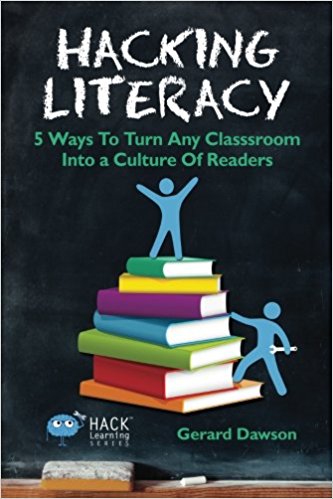The Hack Learning Series of books plays on the “life-hacking” phenomenon where people share tips and tricks to increase productivity and efficiency in various walks of life. This is the first book I’ve read so far, but other interesting titles include: Hacking Assessment, Hacking Education and Make Writing.

tl;dr:
- Readability: ★★★★★ A succinct book with plenty of practical tips. Bonus: Easy to carry around on the bus or MRT.
- Usefulness for teaching: ★★★★☆ Practical tips to change school-wide reading culture from the bottom-up. But the book doesn’t focus enough on deeper reading - just the act of getting kids to read.
- Applicability to SG: ★★★☆☆ Lots of schools already have some sort of reading programme in place (e.g. silent reading during morning assembly). If your school already does that, some of Dawson’s suggestions (5-minutes of daily reading time instead of weekly blocks) might be hard to justify.
3 tips from the book:
1. Focus on the reader
“Teachers must… patiently guide students to shape [their] self-images as readers.”
Reluctant readers often don’t know where they can find books that will appeal to them. Dawson recommends that reading programmes must be paired with book-matching programmes, where teachers work together with school and public libraries to regularly create and update book displays, and students are taught to create their own To-Read lists, scan blurbs, use online resources such as Goodreads, and self-assess their books for their reading difficulty.
One great idea is to create speed-dates with books, a modified gallery walk where students cycle through desks with ~3-5 books on them, rate their first impressions of the book using post-its, and then come together with the rest of the class to discuss which books the class liked best, and why. At the end of the activity, students update their To-Read lists with at least one book they’ve encountered during the speed-dating activity.
2. Start small
Reluctant readers tend to get distracted or bored during prolonged periods of silent reading. Rather than mandate 30-minute or hour-long reading sessions on a weekly basis, Dawson argues that setting aside 5 minutes of each day is far more effective. During that time, teachers could model reading (bringing their books along to lessons and reading silently along with readers), or check-in with 2-4 students, noting the books and page numbers they’re at and asking them questions about their reading.
For non-fiction, Dawson recommends starting with articles rather than full-length books. Students can subscribe to Feedly.com, an online news aggregator which “watches” websites for updates on selected topics and collates new articles. This makes non-fiction reading less daunting, and students can finish a short article each reading session, building their stamina over time.
3. Implement assessments that build community
“Students feel that an activity has inherent value when they communicate [their] experiences of a text to a real audience.”
More than providing knowledge about a student’s reading ability and knowledge, assessments are a chance to deepen students’ reading experiences and create a classroom culture of reading. However, the “book talk” has a tendency to intimidate students who fear both reading and public speaking. To ease students into talking about the books that they’re reading, Dawson gets students to do a “three-sentence” book talk, answering the following three questions:
- What’s the gist of the plot / topic?
- Why did you like / dislike the book?
- Who else should read the book?
Dawson also starts off the year with modelling the three-sentence book talk on a weekly basis, acknowledging that many students will not have had the chance to observe literate adults discussing their reading. It is only at the end of the first few months that students are ready to take over on their own.